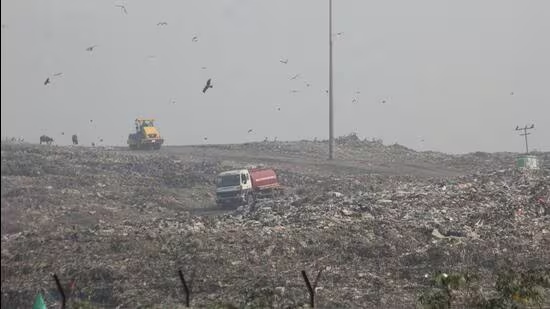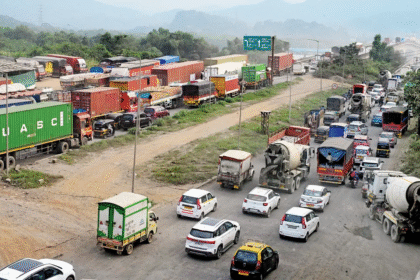The Cleanup Begins — A New Chapter for Deonar
Mumbai’s notorious Deonar Dumping Ground, often synonymous with choking smoke and mounting waste, is finally moving toward transformation. In July 2025, the Brihanmumbai Municipal Corporation (BMC) officially awarded a high-profile cleanup contract to Navayuga Engineering Company, marking a major milestone in the city’s ongoing battle against escalating environmental and public health concerns.
A Long-Standing Environmental Crisis
For decades, the Deonar landfill—one of Asia’s largest—has been a source of constant community distress. McCloses of burning trash, foul odours drifting over nearby areas, and frequent flare-ups of fire have plagued residents living in adjacent neighborhoods like Govandi and Chembur. Local schools often serve as makeshift shelters during high-smoke days, and municipal departments have long warned of severe respiratory and ecological impacts.
Earlier attempts to manage the growing crisis—ranging from mechanized waste turning to intermittent composting initiatives—have met with limited success. But persistent fires, collapsing embankments, and health advisories continued to mark the Deonar landscape. For many Mumbaikars, hope had dimmed.
Why Navayuga Won the Bid
The BMC’s decision to contract Navayuga Engineering Company follows a rigorous selection process that evaluated expertise, equipment capability, timeline delivery, and financial accountability. Navayuga stood out thanks to:
- Proven technical excellence in large-scale infrastructure and environmental projects across India.
- A modern fleet of waste handling machinery, capable of managing both landfill excavation and scientific restoration.
- A comprehensive project timeline, including immediate mitigation measures followed by long-term site rehabilitation.
- A financial plan ensuring accountability, with clear budget allocation for stages such as waste segregation, site leveling, and soil remediation.
This alignment of technical readiness and project vision positioned Navayuga as the front-runner in BMC’s selection.
Immediate and Long-Term Objectives
Phase 1 (Months 0–6) will prioritize fire suppression, waste excavation, and initial segregation efforts. Engines will be ramped up at targeted hotspots, with dedicated teams working in shifts to bring down smoke output and reduce flare-up risks.
Phase 2 (Months 7–18) emphasizes scientific rehabilitation: removing non-degradable raw waste, installing impermeable liners, deploying methane-capturing technology, and backfilling with inert soil. This phase will also introduce drainage systems and vegetation to stabilize the terrain.
Phase 3 (Months 19–36) focuses on sustainable aftercare: community engagement, landscaping for eventual public use, ongoing monitoring of soil and air quality, and capacity building for community-level waste reduction programs.
According to BMC’s roadmap, the project’s overarching goal extends beyond cleanup; it is an opportunity to redefine Mumbai’s long-term waste policies. Interim updates from Navayuga promise a transparent online dashboard tracking progress, funding utilisation, and public feedback.
Reasons Mumbai Needs This Now
There’s no shortage of reasons why this intervention is both urgent and overdue:
- Public health emergencies: Spike in respiratory illnesses among children and the elderly during fire outbreaks.
- Economic fallout: Frequent shut-downs in nearby industrial and educational zones due to toxic air.
- Ecological consequences: Leaching of heavy metals and organic pollutants into local groundwater tables.
- Urban planning breakthrough: Deonar’s location — not far from Mumbai’s port and transport hubs — offers potential for repurposing the site into green space, eco-parks, or civic amenities once remediated.
For civic advocates and environmental scientists, this initiative is more than infrastructure—it is a symbol of Mumbai’s commitment to climate resilience and urban renewal.
Challenges Ahead
Despite the optimism, the Clean Deonar project is laden with obstacles:
- Technical complexity: Safe excavation and management of compacted landfill require precise engineering and dust-control methods.
- Community engagement: Local residents need to be actively involved in monitoring, reporting, and supporting the cleanup.
- Financial discipline: Project delays or budget overruns could undermine trust and hamper future environmental investments.
- Policy continuity: Future civic administrations must not let broader waste reforms stall midstream.
Experts caution that clear benchmarks, stakeholder accountability, and independent audits will be critical for ensuring the project’s integrity—and its lasting impact.
Looking Forward: A Vision for a Cleaner Mumbai
As Navayuga Engineering gears up for its first day’s operations, civic bodies, NGOs, environmental experts, and local communities share a cautious sense of optimism. Should the cleanup unfold as planned, Deonar could become a case study in urban landfill regeneration, reclaiming hundreds of acres for public use while setting Mumbai on a new path toward zero-burning, zero-waste practices.
This marks not just a clean-up of rubbish, but a turning point in how India’s largest city confronts the intersection of urbanization, public health, and environmental stewardship.
The decision to entrust Navayuga Engineering Company with the rehabilitation of Deonar Dumping Ground not only signaled a pivotal step in urban environmental renewal, but it also set the stage for one of the most technically ambitious landfill remediation efforts in India’s history. This part delves into the engineering backbone of the cleanup: the machinery, methods, and science driving the transformation of a mountain of waste into a symbol of sustainability.
Scientific Landfill Mining: The Core Strategy
At the heart of Navayuga’s plan is a method known as scientific landfill mining. Unlike ad hoc excavation, this technique involves:
- Systematic excavation of legacy waste using heavy-duty backhoe loaders and chain excavators.
- On-site segregation using semi-automated trommel machines that separate recyclable materials, inert soil, and refuse-derived fuel (RDF).
- Volume reduction by recovering non-biodegradable, recyclable waste and directing it to recyclers or waste-to-energy plants.
- Land reclamation through filling the cleaned zones with inert soil and creating usable land for potential urban utility.
Such mining processes are already being implemented in cities like Indore and Bengaluru, but Deonar’s scale—240 acres of accumulated waste—is unprecedented.
Machinery Deployed at Deonar
Navayuga has deployed an industrial-grade equipment fleet tailored to handle multi-layered, decades-old municipal solid waste:
- Hydraulic Excavators: For precision digging in dense waste zones without collapsing embankments.
- Trommel Screening Units: Rotating sieves that categorize waste by size and composition.
- Wind Sifters: To extract lightweight materials such as plastics from mixed waste streams.
- Composting Units: On-site modular systems designed to treat organic waste with microbial inputs.
- Leachate Treatment Plants (LTPs): To manage and neutralize the harmful liquid that seeps through decomposing waste piles.
In total, over 100 pieces of machinery are working in tandem across rotating 3-shift cycles, covering close to 7,000–10,000 tonnes of waste daily.
Methane Management: Taming the Fire Hazard
One of the most dangerous legacies of Deonar has been the intermittent fires, primarily caused by the release of methane—an explosive greenhouse gas—trapped under layers of waste.
Navayuga’s engineering model includes:
- Methane venting bores: Strategically placed pipes that release gas pressure safely into the atmosphere.
- Flaring systems: High-temperature combustion chambers that burn excess methane on-site, converting it to CO₂, which has a lower environmental footprint.
- Future methane capture units: As the landfill stabilizes, Navayuga aims to redirect methane to energy conversion units for lighting or heating purposes—a model employed successfully in parts of Europe.
These technologies collectively reduce the fire hazard while contributing to lower emissions.
Geo-Fencing and Drone Surveillance
To maintain operational discipline and safety, the coEven as massive machines rumble across Deonar’s 240 acres, churning up decades of waste under the eye of precision GPS systems and drones, the true transformation goes beyond the physical. The real success of Deonar’s rehabilitation lies in its impact on the people who have long lived in its shadow—those who inhaled its toxic air, bore the stigma of its presence, and navigated its complex socio-economic aftershocks.
This chapter brings into focus the human dimension of Deonar’s story—residents of nearby settlements like Shivaji Nagar and Govandi, grassroots health workers, ragpickers-turned-waste entrepreneurs, and civic volunteers who have long fought for dignity and reform.
Govandi: From Living Next to a Dump to Dreaming of Livability
For over 90,000 people residing in the areas surrounding the Deonar dumping ground, life was synonymous with toxicity. Frequent landfill fires would blanket the area with dark smoke, leading to weeks of poor air quality and persistent respiratory infections. Residents describe the odor from the garbage mounds as “permanent,” seeping into their homes, clothes, and even food.
But since Navayuga began its operations:
- Air quality index (AQI) levels have shown marked improvements, with PM2.5 readings dropping by 40–50% during peak work hours.
- Children with asthma, who earlier missed school due to flare-ups, are now reporting reduced symptoms.
- Complaints of skin rashes, nausea, and headaches from fumes and leachate exposure have decreased noticeably according to local clinics.
For many, this is the first time they are beginning to hope that the land they live on could one day be safe, clean, and even prosperous.
Frontline Health Heroes: ASHAs and Mobile Clinics
As part of BMC’s community mitigation plan, health workers known as Accredited Social Health Activists (ASHAs) have been mobilized to survey residents around Deonar. Their tasks include:
- Conducting door-to-door health screenings for respiratory, dermatological, and waterborne illnesses.
- Educating families on how to deal with dust exposure, sanitation practices, and early warning signs of infections.
- Liaising with BMC’s mobile clinics, which now visit each ward twice a week, equipped with basic medicines, oxygen cylinders, and diagnostic kits.
NGOs such as Doctors For You, Apnalaya, and SNEHA have partnered with the health outreach to map long-term health risks and collect anonymized data to guide future policy.
The Forgotten Force: Ragpickers Reintegrated
Among the most overlooked stakeholders in Deonar’s ecosystem were the ragpickers—often women and children—who scavenged through mountains of waste to retrieve plastics, metals, and recyclables. Prior to formal intervention, over 2,000 informal workers operated in and around the landfill, without protective gear, social security, or sanitation.
Now, the narrative is shifting:
- Navayuga, under BMC directives, has facilitated the formation of 8 registered waste-picker cooperatives, offering formal contracts, protective equipment, and access to material recovery centers.
- Training sessions are being held in partnership with Stree Mukti Sanghatana and SWaCH Pune, empowering former ragpickers with business skills and banking access.
- Over 400 women now earn a stable, dignified income, segregating non-hazardous recyclables in safe zones.
This reintegration is not just a form of economic justice—it’s an acknowledgment that sustainability cannot happen without social inclusion.
Urban Renewal in Sight: Education, Roads, and Real Estate
The Deonar landfill has long been a development dead zone, devaluing surrounding real estate and limiting civic investment. But as the cleanup progresses:
- New roads are being proposed connecting Shivaji Nagar to Chembur and Ghatkopar, cutting down commute times by 30–40%.
- Primary schools and anganwadis have seen a rise in attendance and reduced dropout rates.
- Builders and government agencies are now considering the area for future affordable housing schemes once the land is fully remediated and declared stable.
A transformation once thought impossible is now underway: the reclamation of urban land for life, not just for waste.
The Role of Local Activists and NGOs
Deonar’s residents didn’t wait for government intervention to start demanding change. For years, activists like Fatima Sheikh, Sunil Gaikwad, and the Govandi Yuva Sangharsh Samiti held protests, petitioned courts, and documented air pollution data long before official interest took hold.
Their impact is finally being recognized:
- Fatima Sheikh now sits on BMC’s Community Liaison Board overseeing grievance redressal during the remediation.
- Several activists are collaborating with university researchers from TISS and IIT Bombay to document the environmental history of Deonar.
- NGOs such as URBZ, Hamara Footpath, and BlueEdge Foundation are mentoring youth on environmental citizenship and policy literacy.
This shift from confrontation to collaboration marks a new phase of participatory governance in waste management.
Policy Lessons from the Ground
The Deonar remediation project is not an isolated civic contract—it is becoming a case study for urban governance, participatory planning, and environmental justice. Key policy implications include:
- Mandating community representation in all large-scale urban sanitation projects.
- Incorporating health impact assessments (HIAs) as compulsory tools before waste site approvals.
- Establishing a national landfill remediation framework under the Swachh Bharat Abhiyan 2.0, using Deonar as a replicable model.
The Urban Affairs Ministry has already announced a review committee to monitor lessons learned from Deonar and translate them into national-level policy recommendations.mpany has implemented a GIS-based geo-fencing system, tracking:
- Movement of machinery and trucks.
- Entry and exit of segregated waste.
- Temperature variations across the site to predict fire risks.
- Progress of cleared versus uncleared zones.
Drones equipped with infrared sensors fly daily to survey mounds, assess fire risks, and capture visual proof for public transparency reports. BMC is also offering access to a real-time dashboard for citizens and journalists to view progress and milestones.
Community Impact Mitigation
In parallel to its engineering feats, Navayuga is initiating several public health and social safety protocols to protect residents in the vicinity:
- Fogging and deodorization units to neutralize odour emissions.
- Mobile health vans conducting routine checkups in Govandi, Shivaji Nagar, and Mankhurd.
- Dust suppression vehicles spraying water and biodegradable neutralizers on access roads.
- Awareness kiosks and helplines to address community concerns in multiple languages.
Moreover, all workers on-site are mandated to wear PPE kits, with on-ground safety officers ensuring compliance.
Partnerships with Waste-to-Energy & Recycling Sectors
A critical aspect of the project’s success lies in its ability to avoid re-dumping and instead feed segregated waste into productive use:
- Plastics and metals are being sold to certified recyclers at pre-negotiated rates.
- Organic waste is redirected to bio-CNG and composting facilities.
- Combustible waste (RDF) is being supplied to cement factories as an alternative fuel.
- BMC is in active talks with private players to set up a decentralized Waste-to-Energy (WTE) plant nearby, drawing on Navayuga’s output.
This circular waste economy approach is expected to reduce dependence on future landfill creation.
Milestones Achieved (First 60 Days)
- 2.1 lakh metric tonnes of waste excavated.
- 27 acres of landfill partially cleared.
- Five flare units operational, mitigating over 18,000 cubic meters of methane.
- Zero fire incidents since operations began, a first in over a decade.
With initial momentum strong, BMC Commissioner and local ward officials have expressed confidence that the site will see 50% remediation within the first year.
Also Read : Is Modi’s Cheetah Project Working? Doubts Grow Over the Fate of Namibian Cheetahs in India








